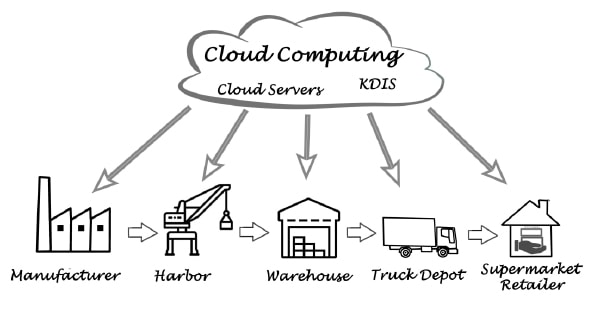The Future of the Supply Chain is Cloudy

We hear a lot about the cloud these days. The cloud (public or private) refers to software and services that run on the Internet instead of locally on your computer. There is a good chance that the majority of business data will eventually reside in the cloud.
There are three main types of cloud computing:
- Infrastructure as a Service (IaaS)
- Platform as a Service (PaaS)
- Software as a Service (SaaS)
The cloud is the backbone of a “smart” supply chain—referred to as Supply Chain 4.0—because it contains the necessary data and interchanges.
To take advantage of all the Supply Chain 4.0 technologies now and in the foreseeable future, the cloud will be integral. Blockchain, the Internet of Things (IoT), artificial intelligence, and the digital supply chain will all require cloud computing.
The cloud centralizes data and then offers access to your extended supply chain network, which decreases costs, speeds velocity, scale, and visibility, and enhances data security. The cloud also helps companies predict market changes and risks across their supply network.
An added benefit: The cloud enables innovation with affordable access to leading-edge technologies and capabilities.
A recent Accenture survey supports these benefits, finding that executives attribute their cloud use to a 26% increase in demand forecast accuracy, 16% reduction in supply chain operating costs, and 5% increase in revenue growth and profitability.
Call for Security
There is one major disadvantage to consider and attempt to minimize: Cloud security issues can put your software supply chain at risk.
To reduce security risks, understand your cloud environment by learning what runs where. Consider a hybrid cloud architecture approach where sensitive data is kept on-premise. Also consider spreading your workloads across different cloud accounts to reduce the impact of any potential breaches.
Finally, stay on top of cloud security issues by following the news and your cloud provider’s security blog.
While traditional on-premise enterprise software or legacy solutions—either custom-built or packaged software—provide a powerful solution with robust features, they are difficult and expensive to acquire, install, and maintain and don’t always keep pace with business demand. They also often require custom programming.
It’s estimated that the global cloud supply chain management market will grow an average of 11% through 2028. The market has been segmented based on solutions, services, deployment models, organization sizes, verticals, and regions.
Many companies already leverage the cloud for supply chain applications including:
- Forecasting and planning. They use the cloud to collect and unify information from customers, retailers, wholesalers, and manufacturers.
- Logistics. The cloud helps companies provide and share tracking operations, automatic inventory management, and route optimization.
- Service and spare parts management. The cloud makes servicing schedules more efficient, which reduces downtime, while RFID and IoT can help track inventory location quickly.
- Procurement. The cloud can serve as a master supplier database and automatically order when inventory reaches a set minimum level. It can also be a platform for contract development and maintenance.
To survive today’s volatile global environment with a lean and agile smart supply chain, start moving to the cloud.

